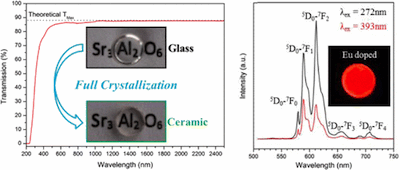Ask for a reprint
email :
* Give your email
2013
ACL
|
S.Alahraché, K.Al Saghir, S.Chenu, E.Véron, D.De Sousa Meneses, A.I.Becerro, M.Ocaña, F.Moretti, G.Patton, C.Dujardin, F.Cussó, J.P.Guin, M.Nivard, J.C.Sangleboeuf, G.Matzen, M.Allix, 'Perfectly transparent Sr3Al2O6 polycristalline ceramic elaborated from glass crystallization', Chem. Mat. 25 4017-4024 (2013) doi:10.1021/cm401953d
The highly visible and infrared (up to 6 μm) transparent Sr3Al2O6 polycrystalline ceramic was obtained by full crystallization of the corresponding glass composition. The glass synthesis and the direct congruent crystallization processes are described and the material transparency is discussed in light of its microstructure. This new transparent ceramic exhibits high density (i.e. complete absence of porosity) and micrometer scale crystallites with very thin grain boundaries. These microstructural characteristics,
inherent to the preparation method, minimize light scattering and demonstrate the advantages of this synthesis route compared to the high pressure process used for the few reported transparent polycrystalline materials. This Sr3Al2O6 ceramic shows a H=10.5 GPa hardness, a Er=150 GPa reduced elasticity modulus and a 9.6.10-6 K-1 thermal expansion coefficient. Such a transparent strontium aluminate ceramic opens the way to a wide range of applications, especially photonic when doped by various doping agents. As examples, the luminescence of Sr3Al2O6:Eu3+ and Sr3Al2O6:Er3+, showing respectively strong emissions in the visible and the infrared ranges, are presented. Moreover, the Sr3Al2O6:Ce3+ material was found to exhibit scintillation properties under Xray excitation. Interestingly, the analogous Sr3Ga2O6 transparent polycrystalline ceramic material could equally be prepared using the same elaboration method, although its hygroscopicity prevents high transparency to be preserved under normal conditions. The establishment of the transparency key factors of this economical and innovative synthesis method should enable to predict new
classes of technologically relevant transparent ceramics.
|

|